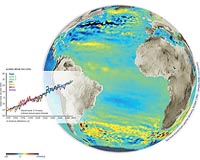 |
Greenbelt MD (SPX) Dec 09, 2009 NASA's effort to deploy the first satellite mission to advance global precipitation observations from space moved closer to this goal when agency officials approved critical elements for the Global Precipitation Measurement (GPM) mission on Dec. 2. NASA gave GPM the green light to proceed to the mission implementation phase in a review meeting chaired by NASA's Associate Administrator Christopher Scolese. Building on the success of the Tropical Rainfall Measuring Mission (TRMM), a joint project between NASA and the Japan Aerospace Exploration Agency (JAXA), GPM will usher in a new generation of space-based observations of global precipitation, a key element of the Earth's climate and also the primary source of freshwater. GPM is an international collaboration that currently includes NASA and JAXA, with anticipated contributions from additional international partners. "This joint NASA/JAXA mission is scientifically important and stands as a prime example of the power of international cooperation in Earth observations," said NASA's Earth Science Division director Michael Freilich. "GPM's global precipitation measurements will advance our abilities to monitor and accurately predict precipitation on a global basis. GPM builds on the strong scientific and technical collaborations developed between NASA and JAXA. GPM instruments will also provide key calibration references to allow measurements from a wide variety of other satellite missions, including those from other U.S. and international organizations, to be combined to provide accurate predictions and global data sets." The heart of the GPM mission is a spaceborne Core Observatory that serves as a reference standard to unify and advance measurements from a constellation of multinational research and operational satellites carrying microwave sensors. GPM will provide uniformly calibrated precipitation measurements globally every 2-4 hours for scientific research and societal applications. The GPM Core Observatory sensor measurements will for the first time make quantitative observations of precipitation particle size distribution, which is key to improving the accuracy of precipitation estimates by microwave radiometers and radars. The GPM Core Observatory will carry a Dual-frequency Precipitation Radar (DPR) and a multi-channel GPM Microwave Imager (GMI). DPR will have greater measurement sensitivity to light rain and snowfall compared to the TRMM radar. GMI uses a set of frequencies to retrieve heavy, moderate, and light precipitation from emission and scattering signals of water droplets and ice particles. GPM is the cornerstone of the multinational Committee on Earth Observation Satellites Precipitation Constellation that addresses one of the key observations of the Global Earth Observation System of Systems. NASA is responsible for the GPM Core Observatory spacecraft bus, the GMI carried on it, the Core Observatory integration, launch site processing, mission operation and science data processing and distribution. NASA is also responsible for the development of a second GMI to be flown on a partner-provided Low-Inclination Observatory (LIO) and the Instrument Operational Center for the LIO. The GPM Core Observatory is scheduled for launch in July 2013 from JAXA's Tanegashima launch site on an H-IIA rocket. NASA's Goddard Space Flight Center in Greenbelt, Md., manages the GPM mission on behalf of the Earth Science Division of the Science Mission Directorate at NASA Headquarters. Goddard oversees the in-house Core Observatory development and the GMI acquisition from Ball Aerospace and Technologies Corporation of Boulder, Colo. The GPM project life cycle cost is $978 million. Share This Article With Planet Earth
Related Links Global Precipitation Measurement mission Earth Observation News - Suppiliers, Technology and Application
 ESA To Attend COP15 Climate Conference
ESA To Attend COP15 Climate ConferenceCopenhagen, Denmark (ESA) Dec 07, 2009 Government representatives from around the world will gather at the UN Climate Change Conference in Copenhagen, Denmark, 7-18 December, to negotiate a deal to restrict emissions of heat-trapping gases that drive climate change. ESA will attend the conference - also known as COP15 as it will be the 15th Conference of the Parties to the UN Framework Convention on Climate Change (UNFCCC) ... read more |
|
| The content herein, unless otherwise known to be public domain, are Copyright 1995-2009 - SpaceDaily. AFP and UPI Wire Stories are copyright Agence France-Presse and United Press International. ESA Portal Reports are copyright European Space Agency. All NASA sourced material is public domain. Additional copyrights may apply in whole or part to other bona fide parties. Advertising does not imply endorsement,agreement or approval of any opinions, statements or information provided by SpaceDaily on any Web page published or hosted by SpaceDaily. Privacy Statement |